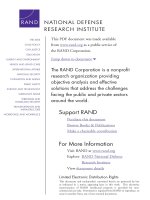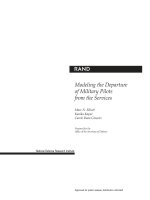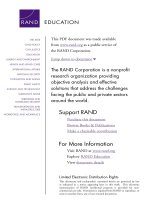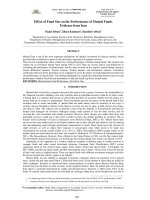The Cost-Effectiveness of Military Advertising - Evidence from 2002-2004 ppt
Bạn đang xem bản rút gọn của tài liệu. Xem và tải ngay bản đầy đủ của tài liệu tại đây (3.68 MB, 52 trang )
This document and trademark(s) contained herein are protected by law as indicated in a notice appearing later in
this work. This electronic representation of RAND intellectual property is provided for non-commercial use only.
Unauthorized posting of RAND PDFs to a non-RAND Web site is prohibited. RAND PDFs are protected under
copyright law. Permission is required from RAND to reproduce, or reuse in another form, any of our research
documents for commercial use. For information on reprint and linking permissions, please see RAND Permissions.
Limited Electronic Distribution Rights
This PDF document was made available from www.rand.org as a public
service of the RAND Corporation.
6
Jump down to document
THE ARTS
CHILD POLICY
CIVIL JUSTICE
EDUCATION
ENERGY AND ENVIRONMENT
HEALTH AND HEALTH CARE
INTERNATIONAL AFFAIRS
NATIONAL SECURITY
POPULATION AND AGING
PUBLIC SAFETY
SCIENCE AND TECHNOLOGY
SUBSTANCE ABUSE
TERRORISM AND
HOMELAND SECURITY
TRANSPORTATION AND
INFRASTRUCTURE
WORKFORCE AND WORKPLACE
The RAND Corporation is a nonprofit research
organization providing objective analysis and effective
solutions that address the challenges facing the public
and private sectors around the world.
Visit RAND at www.rand.org
Explore the RAND National Defense Research Institute
View document details
For More Information
Purchase this document
Browse Books & Publications
Make a charitable contribution
Support RAND
This product is part of the RAND Corporation documented briefing series. RAND
documented briefings are based on research briefed to a client, sponsor, or targeted au-
dience and provide additional information on a specific topic. Although documented
briefings have been peer reviewed, they are not expected to be comprehensive and may
present preliminary findings.
NATIONAL DEFENSE RESEARCH INSTITUTE
The Cost-Effectiveness of
Military Advertising
Evidence from 2002–2004
James N. Dertouzos
Prepared for the Office of the Secretary of Defense
Approved for public release; distribution unlimited
The RAND Corporation is a nonprofit research organization providing objective analysis
and effective solutions that address the challenges facing the public and private sectors
around the world. RAND’s publications do not necessarily reflect the opinions of its
research clients and sponsors.
R
®
is a registered trademark.
© Copyright 2009 RAND Corporation
Permission is given to duplicate this document for personal use only, as long as it is unaltered
and complete. Copies may not be duplicated for commercial purposes. Unauthorized
posting of RAND documents to a non-RAND Web site is prohibited. RAND
documents are protected under copyright law. For information on reprint and linking
permissions, please visit the RAND permissions page (
permissions.html).
Published 2009 by the RAND Corporation
1776 Main Street, P.O. Box 2138, Santa Monica, CA 90407-2138
1200 South Hayes Street, Arlington, VA 22202-5050
4570 Fifth Avenue, Suite 600, Pittsburgh, PA 15213-2665
RAND URL:
To order RAND documents or to obtain additional information, contact
Distribution Services: Telephone: (310) 451-7002;
Fax: (310) 451-6915; Email:
The research described in this report was prepared for the Office of the Secretary of Defense
(OSD). The research was conducted in the RAND National Defense Research Institute,
a federally funded research and development center sponsored by the OSD, the
Joint Staff, the Unified Combatant Commands, the Department of the Navy, the
Marine Corps, the defense agencies, and the defense Intelligence Community under
Contract W74V8H-06-C-0002.
Library of Congress Cataloging-in-Publication Data is available for this publication.
ISBN 978-0-8330-4566-9
iii
Preface
is annotated briefing documents research findings from a RAND project titled “Evaluat-
ing the Effectiveness of Military Advertising.” e project was sponsored by the Director for
Accession Policy (Military Personnel Policy).
is briefing examines the Services’ advertising expenditures for the 2002–2004 time
period and quantifies their impact on active-duty enlistments. Consistent with past research,
the study concludes that advertising was very cost-effective at generating enlistments during
the 2002–2004 period. While improvements could have been made (such as increasing the
budget or adjusting the timing or allocation of dollars across programs), advertising compares
favorably with other methods of generating enlistments, such as adding recruiters or increasing
bonuses.
Unfortunately, data deficiencies were a significant obstacle that limited the scope of the
analysis. Most importantly, gaps in the data made it impossible to assess two categories of
marketing efforts that have been increasing in importance: Internet advertising and sponsored
events. Further, although the results indicate that competition between the Services is impor-
tant, it was not possible to evaluate the separate effects for individual programs other than the
Army.
is research was sponsored by the Office of the Secretary of Defense (OSD) and con-
ducted within the Forces and Resources Policy Center of the RAND National Defense Research
Institute, a federally funded research and development center sponsored by the Office of the
Secretary of Defense, the Joint Staff, the Unified Combatant Commands, the Department of
the Navy, the Marine Corps, the defense agencies, and the defense Intelligence Community.
For more information on RAND’s Forces and Resources Policy Center, contact the
Director, James Hosek. He can be reached by email at ; by phone
at 310-393-0411, extension 7183; or by mail at the RAND Corporation, 1776 Main Street,
Santa Monica, California 90407-2138. More information about RAND is available at
www.rand.org.
v
Contents
Preface iii
Tables
vii
Summary
ix
Introduction
1
Overview of Military Recruiting Programs
3
Review of Past Research
11
e Changing Policy and Media Landscape
17
Research Challenges
21
New Research Findings
27
Implications for Policy and Future Research
35
vii
Tables
1. Regression Results: Army Contracts Per Recruiter 30
2. Regression Results: Log of Total DoD Contracts
34
ix
Summary
e four military Services spent over $600 million on recruiting advertising in 2007. is rep-
resents a 150 percent increase since the 1999 fiscal year (FY). In addition, the mix of advertis-
ing programs has changed significantly. In particular, the Army share of traditional advertising
(primarily print, radio, and television advertising) has gone down relative to the other Services,
especially the Air Force and Marine Corps. In addition, all the Services are spending relatively
more on new advertising vehicles, namely, the Internet and cable television.
ese patterns in the data suggest several policy questions worthy of investigation. First,
does all this spending on advertising produce enlistments? On a marginal cost basis, how does
advertising compare with such alternatives as bonuses or adding more recruiters? Which Ser-
vice programs are most effective? Does this depend on the size or mix of the budget? Finally,
what are the inter-Service effects? Has the increase in the Air Force and Marine Corps budgets
harmed the Army’s and/or Navy’s recruiting efforts?
ese questions are addressed in an econometric analysis of military enlistments. Using
data on advertising expenditures for the 2002–2004 time period, the study controls for other
factors (such as recruiters, bonuses, the local economy, demographic changes, and the mission)
and isolates the impact of advertising on active-duty enlistments.
e results for the Army indicate that advertising remains a very effective recruiting tool.
At spending levels that prevailed during 2000–2002, contracts increased annually by about
13,000. With expansions in the budget, the marginal advertising cost of a contract was about
$10,000. In contrast, the cost from adding recruiters was $15,000. e cost from increasing
bonuses, even if targeted effectively, was over $90,000.
Advertising could have been made even more effective by smoothing spending across the
entire year, allocating a larger portion of the budget to magazine advertising, and increasing
the total advertising budget.
During this time period, the Army was hurt by competing Service programs. In com-
parison with earlier periods, the Air Force, Navy, and Marine Corps had relatively higher
budget levels. is competition reduced the incremental value of advertising to the Army by
50 percent.
Finally, it also worth noting that the marginal costs of all types of military recruiting
efforts (not just advertising) appear to have increased. Given the overall difficulty in meeting
enlistment objectives, this result is not surprising. To meet stable recruiting objectives, the
Army will need more resources than were required previously.
1
Introduction
2 The Cost-Effectiveness of Military Advertising: Evidence from 2002–2004
e first section provides an overview of military recruiting efforts, including changing pat-
terns of spending on advertising.
Next, past research on the effectiveness of these programs is summarized.
e third section outlines many of the economic, behavioral, and technology changes
that have changed the media landscape and are likely to limit the relevance of past research.
e next section identifies some of the major obstacles faced by this new research.
e last sections describe new empirical findings on advertising effectiveness and con-
clude with a discussion of policy implications and directions for future research.
3
Overview of Military Recruiting Programs
In FY 2007, the total recruiting budget for the Army, Navy, Air Force, and Marine Corps
exceeded $3.2 billion, in current dollars. On average, the nominal recruiting budget increased
at an annual rate of over 9 percent, far in excess of inflation. For example, the increase in the
gross domestic product (GDP) deflator over this same period increased at an average annual
rate of less than 2 percent.
Of this total, about $1.8 billion was spent paying and supporting over 13,000 recruit-
ers, including infrastructure and organizational expenses. Advertising and enlistment bonuses
each totaled in excess of $600 million, while college benefits cost $129 million.
In comparison with earlier years, the Services have increased enlistment bonuses the
most, showing a fourfold increase since 1999. Advertising expenditures have increased by 150
percent. Spending on recruiters has increased by 70 percent. In contrast, spending on supple-
mental college benefits (funds that are in addition to the U.S. Department of Defense (DoD)–
wide GI Bill spending) has actually diminished in nominal terms.
4 The Cost-Effectiveness of Military Advertising: Evidence from 2002–2004
On a per-enlistment basis, these costs can be compared across Services and over time. e
above slide indicates that, in 2005, both the Army and Navy spent over $16,000 per recruit.
Today, these average costs are in excess of $20,000. In contrast, the average cost per enlistment
was about $13,000 and $11,000 for the Air Force and Marine Corps, respectively.
Although these costs have risen significantly since 2002, they only partially reflect the
increased difficulty in recruiting. For the Navy and Air Force, the increases stem, in large
part, from reductions in total force and, therefore, accession requirements. Given the existence
of significant fixed or overhead costs (administration and capital costs) that are distributed
over a smaller base of enlistments, it is not surprising that average costs have increased so
dramatically.
Overview of Military Recruiting Programs 5
is graphic examines the trends in the advertising budget since 1986 for all four Services
combined. Current and real dollars spent on national advertising (television, radio, and print)
are presented.
To calculated real dollars, the budgets were adjusted for CPM (cost per 1,000 advertising
impressions, or audience exposures) inflation. ese costs for network television advertising
were reported by the Television Bureau of Advertising and reflect the changing cost for insert-
ing a 30-second television spot as well as the diminishing prime time audience reached by that
ad. Over the last 17 years, the cost of reaching television audiences has increased by over 200
percent, far in excess of GDP inflation.
1
As a result, real advertising spending in 2003 was at the same level as 1986 even though
nominal budgets have doubled. During the 1990s, real spending on advertising was signifi-
cantly lower.
1
CPM actually incurred by the Services (computed by dividing total budget dollars by the cumulative audiences reached
by the advertising as reported by Nielsen) is highly correlated with the general cost inflation reported by the Television
Bureau of Advertising
.
6 The Cost-Effectiveness of Military Advertising: Evidence from 2002–2004
is graphic presents the composition of spending, in real dollars, by Service, for 1986, 1997,
and 2003. It is notable that the Army volume of direct media purchases has gone down sig-
nificantly. At the same time, the Marine Corps and Air Force have experienced large increases.
e Navy’s budget is, in real terms, at about the same level as in 2006, though it was somewhat
lower in 1997.
As we will see, part of the Army’s decline was not due to overall budget cuts but, rather,
to a decision to allocate money to nontraditional media, such as the Internet and sponsored
events.
e relative increase in traditional advertising on the part of the Marine Corps and Air
Force raises important questions concerning the effects of competition in advertising on the
Services. For example, if the Marine Corps and Air Force did increase recruitment as a result
of their budget increases, were the additional contracts drawn from the private sector—a true
market expansion—or did they come at the expense of the Army and Navy?
Overview of Military Recruiting Programs 7
As previously mentioned, the Army’s advertising mix has changed over time. is slide illus-
trates the change for all four Services. Television, including over-the-air broadcast as well as
cable TV, has always represented the largest share. Of course, the composition of this por-
tion has changed over the years, since cable advertising was virtually nonexistent in the 1980s
and early 1990s. Today, about 40 percent of the Army’s television budget is allocated to cable
networks, including ESPN, TNT, and BET, among others. Advertising in radio and print
(magazines and newspapers) has diminished, while advertising through special events (such as
NASCAR and high school all-star football games) and on the Internet (including Web adver-
tisements as well as Army Web site development) is now significant. Event and Internet bud-
gets now represent 10 and 20 percent of total spending, respectively.
ese aggregate data obscure some interesting choices made by individual Services. For
example, the Army and Marine Corps have always emphasized television, while the Navy and
Air Force, until recent budget increases, have chosen to use other media, such as radio and
magazines.
8 The Cost-Effectiveness of Military Advertising: Evidence from 2002–2004
ese patterns in the data suggest several policy questions worthy of investigation. First, does
all this spending on advertising produce enlistments? On a marginal cost basis, how does
advertising compare with such alternatives as bonuses or adding more recruiters? Which Ser-
vice programs are most effective? Does this depend on the size or mix of the budget? Finally,
what are the inter-Service effects? Has the increase in the Air Force and Marine Corps budgets
harmed the Army and/or Navy?
Overview of Military Recruiting Programs 9
It is important to note that advertising outcomes can be evaluated using alternative shorter-
and longer-term metrics. In the short term, advertising can generate leads, induce visits to the
Service’s Web site, increase enlistments, or help fill high-priority jobs. Although all these out-
comes have value, the most important goal is, ultimately, to produce enlistments. Indeed, it is
difficult and sometimes impossible to compare resource alternatives, such as bonuses or recruit-
ers, using alternative measures.
In addition, the long-term outcomes associated with advertising, such as building brand
equity, improving morale, and improving public perceptions, are difficult or even impossible to
measure and certainly do not facilitate comparisons with resource alternatives.
As a result, this study examines enlistments and endeavors to link changes in enlist-
ments with variations in advertising, holding other factors constant. is emphasis should not
imply that the other outcomes are not potentially quite important and highly valued. us, we
should view a positive and cost-effective increase in enlistments as a sufficient criterion for jus-
tifying the advertising budget. However, in the absence of information about other short- and
long-run benefits, it should not be viewed as a necessary condition for budget justification.
10 The Cost-Effectiveness of Military Advertising: Evidence from 2002–2004
Now, a word about methodology. Research in this area relies on econometric techniques that
attempt to link variations in advertising with enlistment contracts while controlling for other
factors. e models should include market variables representing the local private-sector oppor-
tunities and population characteristics. e level of enlistment benefits should be included, as
should the role of recruiter effort (numbers of recruiters, recruiter missions, and the incentives
to achieve them).
Also, the models should be flexible enough to account for complex advertising relation-
ships. For example, advertising may have both threshold and saturation effects. at is, an
advertisement has to be experienced several times before it has an effect. On the other hand, a
message, after it has been heard several times, may no longer have a marginal impact. In addi-
tion, advertising may have dynamic effects as well as interactions. For example, individuals do
not immediately enter the Army upon hearing an ad. Indeed, there may be an extended period
before an action stimulated by an ad will be observed. Some of the interactions could be due to
complementarities between media. For example, a television spot may induce a person to seek
additional information, stimulating reading of magazine ads or Web site visits.
e upshot of this discussion is that the ideal model is complex
2
and requires substantial
quantities of data for estimation. It is critical that there be numerous observations and signifi-
cant variation over time and over cross-sections in the key advertising variables of interest.
2
In the estimates below, we simplify the dynamic structure by combining contemporaneous advertising plus the amounts
from the previous period. Given the high correlation between spending levels from period to period, the biases asso-
ciated with this abstraction from alternative relationships (such as an infinite but declining impact of advertising) are
minimized.
11
Review of Past Research
is section briefly describes previous RAND research on the effectiveness of military
advertising.
12 The Cost-Effectiveness of Military Advertising: Evidence from 2002–2004
e first study
3
analyzed data gathered for the Army for the 1981–1982 period. e informa-
tion included spending on a variety of traditional media, including local newspapers and radio
stations as well as national magazines and network (national) advertising on broadcast televi-
sion and radio. Although the data did not include advertising for the other three Services or
the Office of the Secretary of Defense’s (OSD’s) joint advertising effort, the Army information
was unequalled in its completeness and accuracy. e information was compiled on a monthly
basis, with advertising volume for each medium allocated to 66 geographic areas served by
separate Military Entrance Processing Centers (MEPs). e allocation of national advertising
to individual areas was based on the actual distribution of viewing audiences or readers as mea-
sured by the ratings services: Nielsen (for television), Arbitron (for radio), and the Audit Bureau
of Circulations (for print media).
is study came to several conclusions, including that advertising was effective at pro-
ducing enlistments in the short run and that the cost-effectiveness of this recruiting tool com-
pared favorably with other options, such as enlistment bonuses, military pay, and adding addi-
tional recruiters. e research also concluded that the optimal mix of advertising depended
on the size of the budget. For example, print, radio, or television advertising was the preferred
medium at low, medium, and high budget levels, respectively. Finally, although the Army pro-
gram appeared to be cost-effective, significant improvements would have been possible with
changes in the mix and timing of spending. In particular, more enlistments could have been
3
James N. Dertouzos and Michael Polich, Recruiting Effects of Army Advertising, Santa Monca, Calif.: RAND Corpora-
tion, R-3577-FMP, 1989.
Review of Past Research 13
achieved by spending more on television (instead of radio) and by smoothing spending over
the calendar months of the year.
e second study
4
was also based on information from the early 1980s, but this study was
unique in that it included advertising allocations for all 5 programs (including the joint pro-
gram). Most importantly, the advertising volumes were determined by an experimental design
that allowed for significant variation over time and across geographic units (MEPs). Although
the experiment did not facilitate comparisons of individual media types, it did enable analysis
of the separate programs. e research confirmed the previous findings that advertising was
effective and that it compared favorably with other options for increasing enlistments. All pro-
grams appeared to be effective within standard statistical confidence intervals. Most interest-
ing was the finding that the Services did not appear to compete with one another. Indeed, the
evidence suggested that there were positive spillovers across programs. For example, an increase
in the Air Force program not only helped the Air Force, but also increased enlistments in the
other Services. An interesting question in today’s recruiting and media environment is whether
such effects still prevail or, instead, the Services are increasingly competing with each other for
a fixed pool of candidates.
e last study
5
analyzed advertising programs for the 1993 –1997 period. Unfortunately,
severe data limitations precluded analysis of media mix or the separate Service programs. How-
ever, the analysis was able to examine the overall aggregate impact of military advertising on
enlistment contracts. Consistent with previous research, the study concluded that advertising
was effective but that the small budget lessened the impact. At higher budget levels, the adver-
tising programs would have been even more effective.
4
James N. Dertouzos, e Effects of Military Advertising: Evidence from the Advertising Mix Test, Santa Monica, Calif.:
RAND Corporation, N-2907-FMP, 1989.
5
James N. Dertouzos and Steven Garber, Is Military Advertising Effective? An Estimation of Methodology and Applications
to Recruiting in the 1980s and 90s, Santa Monica, Calif.: RAND Corporation, MR-1591-OSD, 2003.









